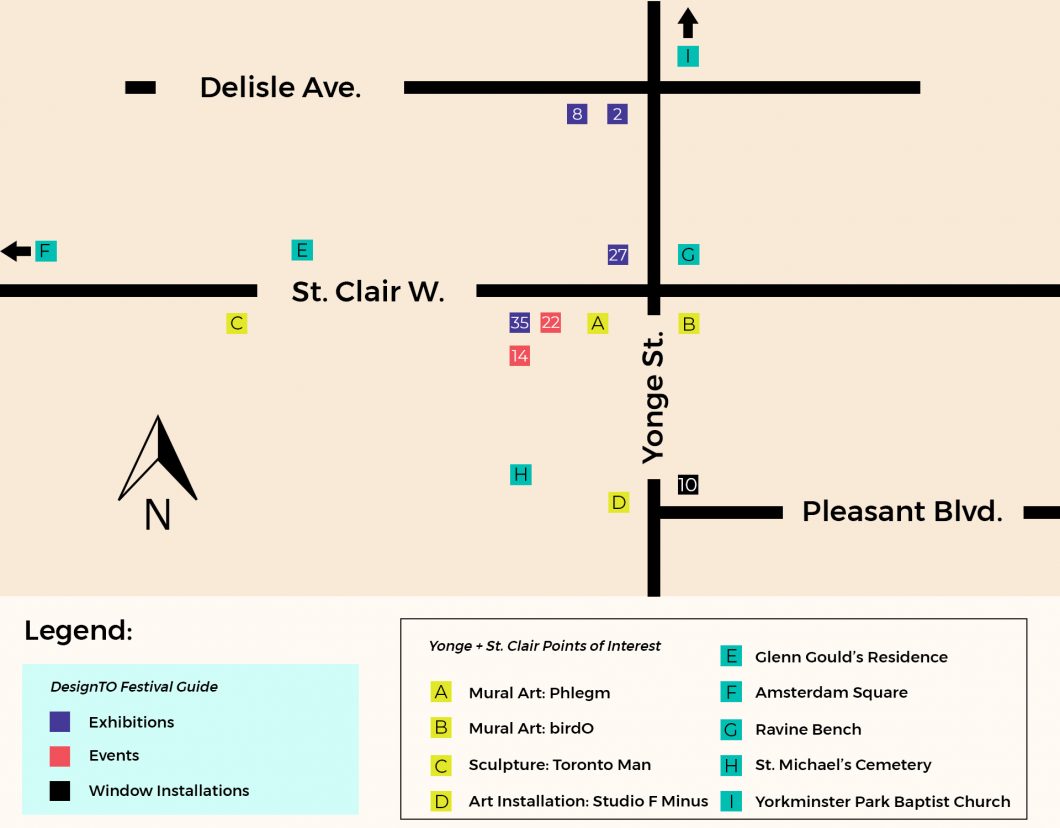Yonge + St. Clair
January 21, 2020
Points of Interest: A Map Of Local Arts + Culture

DesignTO Festival Guide
Please see each exhibition’s opening hours to plan your visit. The DesignTO Festival runs from Jan 17 – 26, 2020.
Exhibitions
2. A Long Story II – Lauren Pirie – 1 Delisle Ave
8. Aborescent – Gensler – 1 Delisle Ave
27. Front of House – Chris Foster and Layne Hinton – 2 St. Clair W
35. Inverted Valleys – Interspatial, Natalia Bakaeva and Mark Francis – 55 St. Clair W
Window Installations
10. Fantasy Foliage – Apoorva Varma – 1407 Yonge St. – Olsson Optical
Events
14. DesignTO Walking Tours: Connection Points – Jan 19, 2020 only
22. DesignTO Ideas Forum: Materializing the Future – Jan 22, 2020 only
Yonge + St. Clair Points of Interest
Find a list of local landmarks, art, and historical points of interest that contribute to Yonge + St. Clair’s cultural legacy.
Murals and Local Art
A. Mural Art: Phlegm – 1 St. Clair W
The 8-storey mural by UK-based artist Phlegm has been a landmark since 2016. The image itself is Phlegm’s creation, but it wasn’t designed in isolation. He proposed the idea of creating a human body out of iconic Toronto landmarks—the CN Tower, old city hall, St. Lawrence Market, the ROM—to represent the city as a vibrant, living ecosystem.
B. Mural Art: birdO – 1 St. Clair E (East-facing wall)
This 10-storey mural is the largest piece that artist birdO, who has done murals all over the world, has ever created. The mural was commissioned by building owners Slate Asset Management and StreetARToronto (StART), and was completed in Fall / Winter 2019.
C. Sculpture: Toronto Man – 95 St. Clair W
The sculpture that sparked a thousand dialogues in 2019, the Toronto Man sculpture by international artist Stephan Balkhenol can be found at 95 St. Clair W.
D. Art Installation: Studio F Minus – 1406 Yonge St. (Laneway)
“Waterfall” was created by Studio F Minus in partnership with the Yonge + St. Clair BIA and is affixed to the laneway wall at 1406 Yonge St. This mirror finished stainless steel piece features flowing steel bands to create the illusion that the building which supports it is vanishing into the sky.
Historical and Architectural Points of Interest
E. Glenn Gould’s Residence – 110 St. Clair W
Celebrated pianist Glenn Gould was born in Toronto and lived here on St. Clair Avenue West for much of his adult life. His visionary approach to musical interpretation brought him international stature. He lived most of his adult life at 110 St. Clair W.
F. Amsterdam Square – 525 Avenue Rd.
Amsterdam Square is located at the corner of St. Clair W and Avenue Road and features an ornamental fountain. The terra cotta fountain in Amsterdam Square was donated to the city by philanthropist Herbert Hale Williams in 1929. It is a replica of the Van Karnebeck Fountain, located on the grounds of the Peace Palace in The Hague, Netherlands.
G. Ravine Bench – 2 St. Clair W
The Ravine Bench represents a piece of the urban renaissance at Yonge + St. Clair, creating more local street space, and a hint of the architectural development philosophies that seek to improve the local landscape. As the designers from Gensler put it, “The design itself is reflective of the ravines that cut through St. Clair. It is a combination of solid stone, plants and the abstracted levels and cuts that break the landscape here. We went through several iterations, but the ravine just felt right and fit so well with the building while also adding some softness and nature to the corner.”
H. St. Michael’s Cemetery – 1414 Yonge St.
Although barred to public access today, St. Michael’s Cemetery was opened in 1855 at the present location at Yonge + St. Clair. Over the years some 29,000 pioneer Catholics of the Toronto Archdiocese, priests, religious and laity, have been buried in these 4 hectares.
I. Yorkminster Park Baptist Church – 1585 Yonge St.
Built in the Gothic Revival style, the church is made of Owen Sound rubble stone walls, with Indiana limestone used for the piers, arches and traceried windows in the aisles, nave, and transepts. Its immense size gives Yorkminster Park seating for 1,200 people in the main sanctuary and room for 500 more in the transept and galleries. This is made possible, in part, by having a 55-foot nave unobstructed by pillars, a feat accomplished by a technique not available to the medieval architects of the original York Minster.

